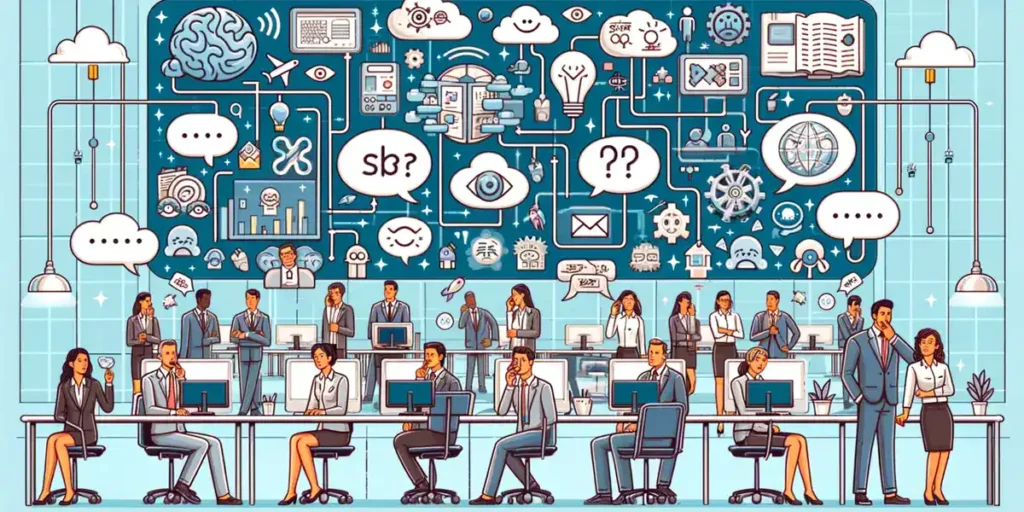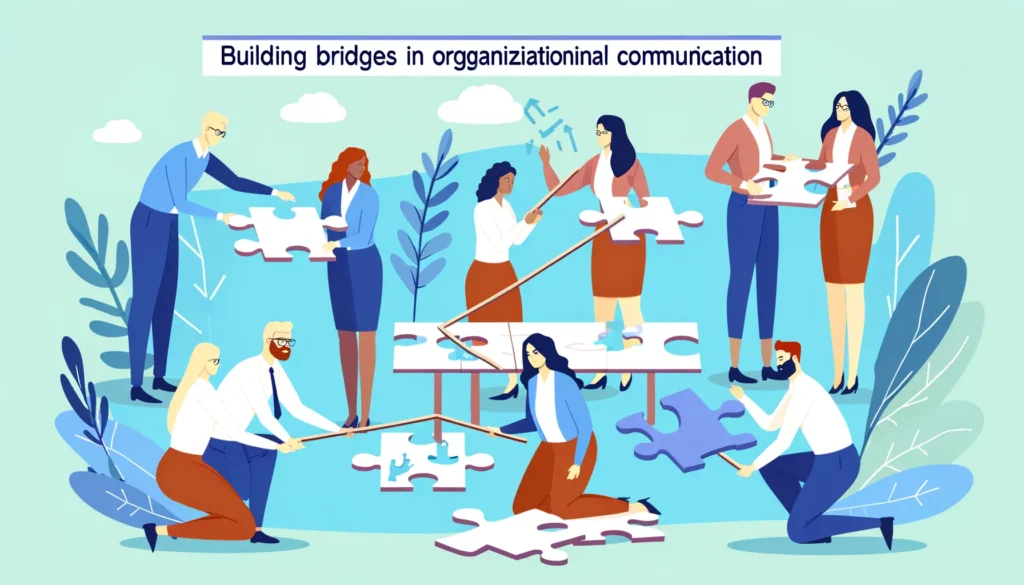Organizational Barriers to Communication
Organizational barriers to communication can significantly impact the success of any business. It is often the case that employees and teams struggle to communicate effectively due to a range of barriers that can impede the flow of information. These barriers can manifest themselves in various ways, including filtering, selective perception, information overload, emotional disconnects, lack of source familiarity or credibility, workplace gossip, semantics, gender differences, differences in meaning between Sender and Receiver, and biased language.
Organizational barriers to communication often include hierarchical structures that limit open dialogue, departmental silos creating isolated teams, and ineffective communication channels that fail to ensure messages are transmitted clearly across the organization.
What is Organizational Barriers ?
Organisational barriers are obstacles within a company that prevent effective communication and information flow. These can include:
- Structural Barriers: Like rigid hierarchies or departmental divides that hinder cross-level or cross-departmental communication.
- Cultural Barriers: Differences in organizational culture, language, or norms that can lead to misunderstandings or exclusion.
- Technological Barriers: Lack of or poor communication tools, or employees not trained to use them effectively.
- Management Style: Authoritarian leadership or lack of open-door policies that discourage open communication.
These barriers can lead to inefficiencies, reduced collaboration, and missed opportunities for innovation.

Organizational Barriers to Communication with Examples
Hierarchical Structures
In organizations with rigid hierarchies, information may not flow freely between different levels. For instance, junior employees might feel hesitant to share their ideas or feedback with senior management due to fear of criticism or being overlooked.
Organizational Silos
Departments within an organization might operate in isolation from one another, leading to a lack of collaboration and shared understanding. For example, the marketing team may not communicate effectively with the product development team, resulting in mismatched product launches.
Cultural Barriers
Differences in organizational culture can lead to misinterpretations and conflict. A company with a diverse workforce might face challenges if cultural sensitivities are not understood or respected. For instance, direct communication styles favored in some cultures may be perceived as rude or aggressive in others.
Information Overload
Employees may be bombarded with too much information, leading to difficulty in processing and prioritizing what is important. For example, receiving numerous emails and messages throughout the day can make it hard to identify critical updates.
Poor Communication Channels
Inadequate or inefficient channels of communication can hinder the dissemination of information. If an organization relies heavily on email for communication, important messages may be missed or delayed amongst a cluttered inbox.
Physical Barriers
The physical layout of an organization can affect how easily employees can communicate. For example, if team members are located in different buildings or on different floors, it may reduce opportunities for face-to-face interaction.
Lack of Transparency
When organizations do not share information openly with employees, it can lead to distrust and rumors. For instance, if management makes decisions without explaining the rationale to employees, it can lead to speculation and anxiety.
Filtering
Information that passes through multiple levels within an organization may be selectively filtered or altered, either intentionally or unintentionally. Managers might withhold negative feedback or critical information from superiors to present their team in a more favorable light.
Technological Barriers
Reliance on specific technologies that are not universally accessible or user-friendly can create barriers. For example, using specialized software that not all employees are trained to use can limit effective communication.
Here are some common organizational barriers along with examples:

Organizational barriers to communication can manifest in several types of organizational barriers such as environmental, structural, cultural, language, and technological factors. By understanding these causes, organizations can take steps to overcome these barriers and enhance communication within their teams.
Barriers Within the Organization
Effective communication is critical for the success of any organization. However, there are several barriers within the organization that can hinder communication and negatively impact productivity. This section will discuss two common barriers within the organization: Interpersonal Barriers and Attitudinal Barriers.
Interpersonal Barriers
Interpersonal barriers refer to communication issues that arise due to personal differences or conflicts between individuals within the organization. These barriers may occur at any level of the organization, from the top management to the frontline employees. Some common interpersonal barriers include:
- Deficiency in communication skills: Individuals who lack effective communication skills may struggle to convey their message clearly, leading to misunderstandings and misinterpretations.
- Hesitant communication: Some individuals may be hesitant to communicate their ideas or opinions due to fear of rejection or criticism. This can lead to important information being withheld, which can negatively impact the organization’s decision-making process.
- Inconsiderate behavior: Individuals who exhibit inconsiderate behavior towards their colleagues may create a hostile work environment, leading to poor communication and reduced productivity.
To overcome interpersonal barriers, organizations can encourage open communication and provide training to improve communication skills. It is also important to foster a culture of respect and inclusivity within the organization.
Attitudinal Barriers
Attitudinal barriers refer to communication issues that arise due to negative attitudes or perceptions towards communication within the organization. These barriers may include:
- Lack of trust: Individuals may be hesitant to communicate openly if they do not trust their colleagues or the organization’s leadership.
- Resistance to change: Individuals who are resistant to change may be hesitant to communicate their ideas or opinions, leading to missed opportunities for innovation and growth.
- Lack of motivation: Individuals who lack motivation may not be interested in communicating effectively, leading to poor communication and reduced productivity.
To overcome attitudinal barriers, organizations can work to build trust and encourage a positive attitude towards communication. This can be achieved through effective leadership, clear communication policies, and a focus on employee engagement and motivation.
Interpersonal and attitudinal barriers can hinder communication within an organization, leading to reduced productivity and missed opportunities. By addressing these barriers, organizations can improve communication and create a more positive and productive work environment.
Effect of Communication Barriers on Organization’s Performance
Communication barriers can have a significant impact on an organization’s performance. When communication is impeded, it can lead to misunderstandings, misinterpretations, and a lack of clarity. This can cause delays in decision-making, a decrease in productivity, and a decrease in the quality of work. Ultimately, it can also result in a commercial failure of an organization.
One of the most significant effects of communication barriers is a decrease in productivity. When employees are unable to communicate effectively, they may not be able to complete their work in a timely manner. This can lead to missed deadlines, delayed projects, and a decrease in the overall output of the organization. In addition, misunderstandings and misinterpretations can lead to errors, which can further decrease productivity.
Communication barriers are common in organizations, and they can occur for a variety of reasons. For example, language barriers, cultural differences, and technological issues can all impede communication. In addition, personal biases and prejudices can also create communication barriers, as can a lack of trust between employees.
The impact of communication barriers might result in a commercial failure for an organization. For example, if a company is unable to communicate effectively with its customers, it may lose business to competitors. Similarly, if employees are unable to communicate effectively with each other, it can lead to a decrease in the quality of work, which may cause customers to lose faith in the organization.
Communication barriers can have a significant impact on an organization’s performance. They can lead to a decrease in productivity, a decrease in the quality of work, and, ultimately, a commercial failure of an organization. It is important for organizations to identify and address communication barriers in order to ensure that their employees are able to communicate effectively and work together to achieve common goals.
How to Overcome Organizational Barriers in Communication?
Overcoming organizational barriers in communication involves a multi-faceted approach:
Flatten Hierarchies
Encourage open communication by reducing the layers of management. Implement policies like open-door policies or regular town hall meetings where employees can voice concerns or ideas directly to leadership.
Foster a Collaborative Culture
Break down silos by promoting cross-departmental projects, team-building activities, and creating a culture where sharing information is valued. Use cultural training to bridge language or norm differences.
Improve Communication Tools and Training
Invest in modern, reliable communication technologies. Ensure all employees are trained not only on how to use these tools but also on communication best practices, like active listening and clear messaging.
Leadership Example
Leaders should model effective communication. They should be approachable, transparent about company goals, and actively solicit feedback. Leadership training can help in developing these skills.
Regular Feedback Mechanisms
Implement systems for continuous feedback like surveys, suggestion boxes, or digital platforms where employees can express concerns anonymously if they prefer.
Encourage Informal Networks
Allow for informal communication channels where employees can interact freely. This can lead to organic problem-solving and idea sharing.
Clear Communication Policies
Establish and communicate clear protocols for how information should flow within the organization, who should receive what information, and the expected response times.
Evaluate and Adapt
Regularly assess the effectiveness of communication within the organization. Use metrics or surveys to gauge how well information is being shared and understood, and be ready to adapt strategies as needed.
By addressing these areas, an organization can significantly reduce communication barriers, leading to a more cohesive, responsive, and innovative workplace environment.
Challenges in Overcoming Barriers to Organizational Communication
Organisational barriers to effective communication can hinder the flow of information among employees, potentially resulting in faulty or delayed communication. This issue can occur in various segments of an organization, from the lower levels to the top, in both large and small entities, and across different regions. Striving to overcome these barriers is challenging yet crucial for effective communication within the organization.

Barriers to effective communication can take many forms, including physical, emotional, and cultural barriers. Physical barriers can include distance between employees, lack of access to technology, and noise. Emotional barriers can include mistrust, fear, and anxiety. Cultural barriers can include differences in language, beliefs, and values.
One of the biggest challenges in overcoming barriers of communication in organization is ensuring that the flow of information is consistent and reliable. Communication gets delayed and might even be lost if there aren’t proper channels in place.
It is essential to have a well-defined communication process that is adhered to by everyone in the organization. This can encompass regular meetings, feedback sessions, and maintaining open communication channels.
Another challenge is ensuring that the flow of information among the employees is seamless. This can be particularly challenging in large organizations where employees are spread out across different regions.
In such cases, it is essential to have a centralized communication system that can ensure that everyone has access to the same information. This can include using technology such as video conferencing, email, and instant messaging.
Appraisal is another challenge in overcoming organizational barriers to communication. Employees may not feel comfortable sharing their thoughts and opinions if they feel that they will be judged or criticized. It is essential to create a culture of open communication where employees feel comfortable sharing their thoughts and ideas without fear of retribution.
Overcoming organizational barriers to communication is essential for effective communication within an organization. This can be challenging, but it is achievable with the right processes and systems in place.
By ensuring that the flow of information is consistent and reliable, that the flow of information among the employees is seamless, and by creating a culture of open communication, organizations can overcome these challenges and improve their communication processes.
How Can Organizational Barriers to Communication Affect Employee Morale and Productivity?
Organizational barriers to communication can have a significant impact on employee morale and productivity. When employees feel that they are not being heard or that their opinions are not valued, they may become disengaged and less committed to their work. This can lead to decreased productivity, lower quality work, and a higher rate of absenteeism and turnover.
One of the most common organizational barriers in business communication is a lack of transparency. When employees are not given access to important information about the company’s goals, strategies, and performance, they may feel that they are not trusted or valued by their employers. This can lead to a sense of frustration and disengagement, which can ultimately impact their productivity and motivation.
Another common barrier to communication is a lack of feedback. When employees do not receive regular feedback on their performance, they may not know how to improve or what they are doing well. This can lead to a sense of uncertainty and anxiety, which can ultimately impact their morale and productivity.
Organizational barriers to communication can also lead to a lack of trust between employees and their managers. When employees feel that their managers are not being honest or transparent with them, they may become suspicious and less willing to share their thoughts and ideas. This can lead to a breakdown in communication and collaboration, which can ultimately impact the quality of work produced by the team.
To overcome these barriers, organizations need to prioritize communication and transparency. This may involve implementing regular feedback mechanisms, providing employees with access to important information, and creating a culture of openness and trust. By doing so, organizations can help to improve employee morale and productivity, which can ultimately lead to better business outcomes.
Conclusion
Effective communication is vital for any organization to thrive. However, communication barriers can arise due to various factors that may be attributed to the sender or receiver. Therefore, it is imperative to communicate within the organization to ensure everyone is on the same page.
Organizational facilities mean the physical environment in which communication takes place. It is crucial to have a conducive environment where employees can communicate freely without any distractions. Face-to-face communication is also essential as it allows for immediate feedback and clarification.
Receivers of communication may hesitate to ask questions or seek clarification, leading to misinterpretation of information. Therefore, it is crucial to create a suggestion box or a feedback mechanism where employees can provide feedback anonymously.
To overcome communication barriers, it is essential to have everyone on the same page. This means that everyone should understand the goals and objectives of the organization. This can be achieved through regular meetings, training, and workshops.
Communication barriers can also arise due to differences in language, culture, or gender. Therefore, it is crucial to be sensitive to these differences and ensure that communication is inclusive and respectful.
Effective communication is vital for any organization to thrive. Communication barriers can arise due to various factors, but it is possible to overcome them through effective communication strategies. By creating a conducive environment, providing feedback mechanisms, and ensuring everyone is on the same page, organizations can communicate within and thrive.
FAQs
How can Communication Affect the Flow of Work in an Organization?
Effective communication ensures smooth workflows in an organization by promoting clear understanding, reducing errors, and fostering collaboration. Poor communication, on the other hand, can lead to misunderstandings, delays, and lower productivity, disrupting overall work efficiency.
How does leadership style influence communication barriers?
The leadership style within an organization significantly influences how communication barriers are perceived and managed. An authoritarian leadership might suppress open communication by creating an environment where employees fear speaking up, thus erecting a barrier to upward communication. In contrast, a transformational leadership style encourages open dialogue, feedback, and innovation, actively working to dismantle communication barriers by fostering a culture of trust and inclusivity.
Can technology both cause and solve communication barriers in organizations?
Organizational barriers can cause delays, misunderstandings, and reduce morale, leading to decreased productivity. When employees feel disconnected or undervalued, motivation and collaboration suffer.






